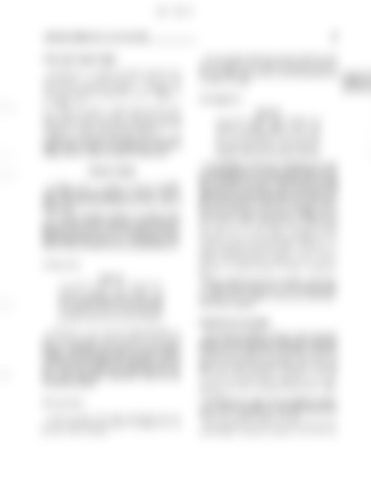©eBlue-Dist 2007
TROUBLESHOOTING AND TESTING
Trim Sender Output Voltage 1. Operate the trim system and lower engine to fully down position. Using a digital multimeter, connect the red tester lead to the terminal (4, Figure 51 or 3, Figure 52). Connect the black tester lead to the terminal (2, Figure 51 or 5, Figure 52). 2. Operate trim system from down to up and verify that down voltage is between -5 and -15 mV and UP voltage is between -1 15 and -125 mV. If test results vary, the trim sender unit is defective and must be replaced. 3. Install the trim sender and connect all leads to the proper location. Refer to the instructions provided in Chapter Eleven to install and adjust the trim sender.
ENGINE NOISES A ticking noise or a knocking noise that intensifies when under load (accelerating) is a reason for concern. Refer to the following information for typical causes of engine noise. If a worn or damaged component is causing engine noise, consider having a professional technician listen to the engine. In many cases, only the trained ear of the technician can determine what component(s) has failed, if any. Repairs to the power head are time-consuming and costly. Ticking Noises
WARNING Use extreme cautioiz when working on or around a running engine. Never wear loose-jtting clothing. Make sure that no one gets near the flywheel or any drive belts. Never position anyone near thepr,opeller or propeller shaft while the engine is running. A ticking noise may result from a damaged piston. Inspect the spark plug for damage or aluminum deposits and perform a compression test as described in this chapter. Complete power head disassembly and repair is required if metal deposits are found on the spark plug. It is necessary to remove the cylinder head to inspect the piston, cylinder walls and related components if there are any compression problems. Whirring Noises A whirring noise that is most pronounced when the throttle is decreased usually relates to a problem with the crankshaft and rod bearings.
Use a mechanic's stethoscope to help identify the cylinder creating the noise. Compare the noise emanating from one area of the engine with the noise from the same area but different cylinder. Knocking Noises
WARNING Use extreme caution when working on or around a running engine. Never wear loose-Jitting clothing. Make sure that no one gets near the jlywheel or any drive belts. Never position anyone near the propeller or propeller shaft while the engine is running. Use a mechanic's stethoscope to determine if the noise is emanating from the power head or other engine component. If a problem exists in the crankshaft and connecting rod components, the noise is more pronounced in the crankcase area. Special insulated pliers are available that allow spark plug lead removal while running the engine. The noise may lessen when the spark plug lead is removed on the suspect cylinder. This procedure is difficult to perform and may result in electrical system damage if the spark plug leads are not properly grounded. A better method is to remove one spark plug lead and attach it to an engine ground. Start the engine and listen to the noise. Install the spark plug lead and repeat the process for another cylinder. If, with one lead grounded, the noise is quieter than another cylinder, the grounded cylinder may be damaged. Always check for lack of oil or incorrect oillfuel mixture. When combined with low or no oil, knocking noises generally indicate a problem with the power head. Major repair may be required. Lubrication System Failure If lubrication is insufficient, internal engine component damage will result. Knocking or other noise is almost always present with lubrication system failures. The engine may stop and not crank with the starter. On occasion, the engine cranks after cooling, but it likely slows down and stops again. When the engine is restarted, it may run rough or not idle. Performance is lacking as well. The engine eventually seizes and requires extensive and expensive repair. If you suspect the engine ran with insufficient lubrication, perform a compression test. The pistons and cylinder walls may be scuffed, scored or damaged. Lubrication failure can result from insufficient oil in the cylinder block or contamination of the oil with fuel or wa-











